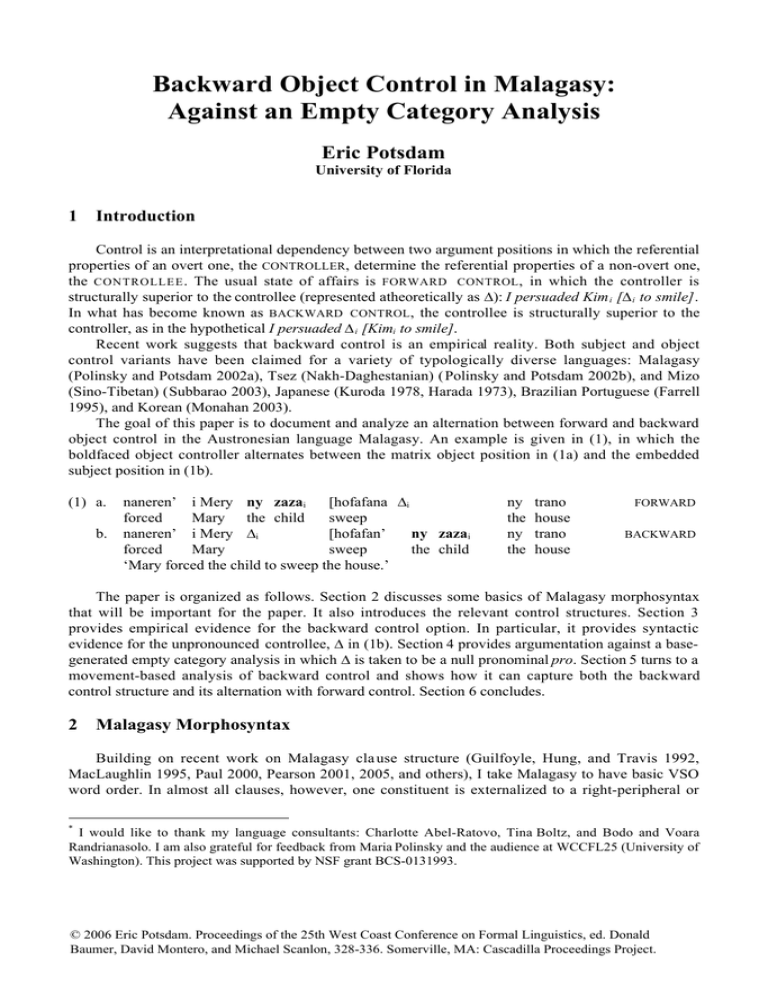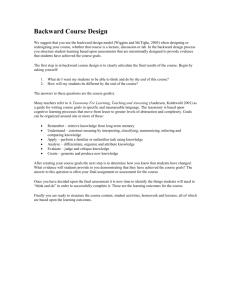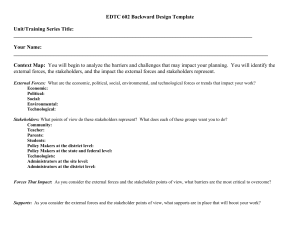Backward Object Control in Malagasy: Against an Empty Category Analysis Eric Potsdam
advertisement

Backward Object Control in Malagasy: Against an Empty Category Analysis Eric Potsdam University of Florida 1 Introduction Control is an interpretational dependency between two argument positions in which the referential properties of an overt one, the CONTROLLER, determine the referential properties of a non-overt one, the CONTROLLEE . The usual state of affairs is FORWARD CONTROL , in which the controller is structurally superior to the controllee (represented atheoretically as ∆): I persuaded Kim i [∆i to smile]. In what has become known as BACKWARD CONTROL, the controllee is structurally superior to the controller, as in the hypothetical I persuaded ∆i [Kimi to smile]. Recent work suggests that backward control is an empirical reality. Both subject and object control variants have been claimed for a variety of typologically diverse languages: Malagasy (Polinsky and Potsdam 2002a), Tsez (Nakh-Daghestanian) (Polinsky and Potsdam 2002b), and Mizo (Sino-Tibetan) (Subbarao 2003), Japanese (Kuroda 1978, Harada 1973), Brazilian Portuguese (Farrell 1995), and Korean (Monahan 2003). The goal of this paper is to document and analyze an alternation between forward and backward object control in the Austronesian language Malagasy. An example is given in (1), in which the boldfaced object controller alternates between the matrix object position in (1a) and the embedded subject position in (1b). (1) a. b. naneren’ i Mery ny zazai [hofafana ∆i forced Mary the child sweep naneren’ i Mery ∆i [hofafan’ ny zazai forced Mary sweep the child ‘Mary forced the child to sweep the house.’ ny the ny the trano house trano house FORWARD BACKWARD The paper is organized as follows. Section 2 discusses some basics of Malagasy morphosyntax that will be important for the paper. It also introduces the relevant control structures. Section 3 provides empirical evidence for the backward control option. In particular, it provides syntactic evidence for the unpronounced controllee, ∆ in (1b). Section 4 provides argumentation against a basegenerated empty category analysis in which ∆ is taken to be a null pronominal pro. Section 5 turns to a movement-based analysis of backward control and shows how it can capture both the backward control structure and its alternation with forward control. Section 6 concludes. 2 Malagasy Morphosyntax Building on recent work on Malagasy cla use structure (Guilfoyle, Hung, and Travis 1992, MacLaughlin 1995, Paul 2000, Pearson 2001, 2005, and others), I take Malagasy to have basic VSO word order. In almost all clauses, however, one constituent is externalized to a right-peripheral or * I would like to thank my language consultants: Charlotte Abel-Ratovo, Tina Boltz, and Bodo and Voara Randrianasolo. I am also grateful for feedback from Maria Polinsky and the audience at WCCFL25 (University of Washington). This project was supported by NSF grant BCS-0131993. © 2006 Eric Potsdam. Proceedings of the 25th West Coast Conference on Formal Linguistics, ed. Donald Baumer, David Montero, and Michael Scanlon, 328-336. Somerville, MA: Cascadilla Proceedings Project. 329 clause-final position. Three examples are given in (2a,b,c) in which a boldfaced agent/subject, theme/object, and benefactive/oblique are externalized, respectively. Pearson 2005 calls this externalized element the TRIGGER because it ‘triggers’ specific verbal inflectional morphology depending upon the trigger’s grammatical role. Agents/subjects trigger ACTOR TOPIC (AT) voice morphology on the verb, (2a); themes/objects trigger THEME TOPIC (TT) morphology, (2b); and others/obliques trigger CIRCUMSTANTIAL TOPIC (CT) morphology, (2c).1 (2) a. b. c. n-i-vidy ny akoho i Paoly PAST-AT-buy the chicken Paul ‘Paul bought a chicken.’ no-vidi-n’ i Paoly ny akoho PAST-buy-TT Paul the chicken ‘The chicken was bought by Paul.’ n-i-vidi-anan’ i Paoly ny akoho PAST-AT-buy-CT Paul the chicken ‘Mary was bought a chicken by Paul.’ i Mery Mary In (2a), when the subject is externalized, one has what is traditionally described as VOS word order. The circumstantial example, (2c), is the most helpful in seeing the underlying VSO word order since a non-term (non-core argument) is the trigger and the subject and object are in their base positions.2 The structure that I assume for such clauses is in (3). The external argument is introduced in spec,v. The subject remains in this position in TT and CT clauses and the verb-initial word order results from V˚-to-I˚. The position of the trigger is a right hand specifier of I˚, which I assume is an A'position (Pearson 2005). The voice morphology indicates which element is externalized. (3) [IP [I' buy [vP Paul [ v' v˚ [ VP buy chicken]]]] DP ] TT AT Malagasy has a typical range of three argument object control verbs, including manery ‘force’, manontany ‘ask’, mandresy lahatra ‘convince, persuade’, mampahatsiahy ‘remind’, milaza ‘say to’, miteny ‘tell’, manampy ‘help’, and miangavy ‘request’ (see Randriamasimanana 1986, Paul and Ranaivoson 1998, and Pearson 2001 for earlier discussions of object control verbs). As with simple clauses, the voice morphology allows such verbs to appear in a number of syntactic constructions. A paradigm with manery ‘force’ is given in (4). (4) a. b. c. nanery ahy [hamafa trano] force. AT me sweep.AT house ‘Mary forced me to sweep the house.’ noteren’ i Mery [hamafa trano] force. TT Mary sweep. AT house ‘I was forced by Mary to sweep the house.’ ?naneren’ i Mery ahy [hofafana force.CT Mary me sweep. TT ‘The house, Mary forced me to sweep it.’ i Mery Mary aho 1SG ] ny the trano house In (4a), the clause-final trigger is the agent/subject of ‘force’ and the verb is in the AT form. In (4b), the theme/object is the trigger and the verb bears TT morphology. In (4c), the trigger is the embedded 1 I use the following abbreviations in glossing: 1/2/3-person, ACC-accusative, AT-actor topic, CT-circumstantial topic, FOC-focus, LOC-locative, PREP-preposition, Q-question, SG/ PL-number, TT-theme topic. 2 The post-verbal subject in TT and CT clauses is phonologically ‘bonded’ to the verb (Keenan and Polinsky 1997). This is indicated in the orthography using either an apostrophe (’) or a hypen (-) according to the initial sound of the subject DP. 330 object and the matrix verb is in the CT form. Again one can see the underlying VSOX in the CT structure word order since a non-term of the matrix clause is the trigger. In all three cases, the subject of the complement clause is unpronounced as is expected of the controllee in forward control. Malagasy has no dedicated morphological infinitives; controlled complement clauses typically have the verb in the irrealis form (also called future tense) marked by h(o)-. Equipped with this description, my structural analysis of the object control clauses in (4) is (5). The two internal arguments of the object control verb occupy the specifier and complement positions of VP. As before, one element is externalized, transforming a basic VSOX word order into a surface form seen in (4). (5) [IP [I' force [vP Mary [v' v˚ [ VP mei [v' force [IP sweep ∆i house] ]]]] CT TT AT DP ] The main fact of interest in this paper is that in the CT use of the object control verb, the theme (the forcee) can be expressed in two positions. In (6a), the boldfaced theme is expressed in the matrix clause object position. This is forward object control. In (6b), the theme surfaces in the embedded clause subject position. This is the backward object control example. There is no detectable meaning difference between the two examples according to my consultants.3 4 (6) a. b. ?naneren’ i Mery ahy [hofafana ] force.CT Mary me sweep. TT ?naneren’ i Mery [hofafa- ko ] force.CT Mary sweep.TT I ‘Mary forced me to sweep the house.’ ny the ny the trano house trano house FORWARD BACKWARD I propose that the backward object control example in (6b) has essentially the same structure as (6a) except that the relationship between the controller and the controllee is reversed. The matrix object is unpronounced and the embedded subject is overt: 3 Following Pearson 2005, pronouns have three forms: an accusative form, a bound nominative form, and a strong default form which appears in the topic position and is unmarked for case. In the first person, these three pronominal forms are ahy ‘me’, -ko ‘I’, and aho ‘1SG’, respectively. 4 Some CT object control examples are degraded in acceptability. There are two reasons for this. First, the circumstantial voice is morphologically marked and is much less common in spoken language than the AT and TT voice forms (Keenan and Manorohanta 2001). Speakers do accept such sentences more readily after some priming by other CT examples. Second, the structure of such examples is more complex in that the embedded object is externalized and there needs to be a good reason, discourse-wise, to do this. One situation in which the embedded objectmust be externalized is question formation. As is well-known about Malagasy, only matrix triggers can be questioned (see Keenan, 1976, Paul, 2000, Pearson 2001, and others for discussion). Thus, in order to question the embedded object in an object control structure, the voice system must be used to first make that element the matrix trigger. The CT control structure is the obligatory. The question variants of (6a,b) in (i) are fully acceptable as this is the only way to form the desired questions. Wh-questions in Malagasy are formed by fronting the trigger and following it with the particle no (glossed FOC(US)). (i) a. b. forward object control (question) tranon’ iza no naneren’ i Mery house who FOC force.CT Mary backward object control (question) tranon’ iza no naneren’ i Mery house who FOC force.CT Mary ‘Whose house did Mary force me to sweep?’ ahy me hofafana? sweep.TT hofafasweep.TT FORWARD ko? I BACKWARD The importance of this observation is that some of the examples below will be in the form of questions, to facilitate the grammaticality judgments for speakers. This does not affect the points being made. 331 (7) [IP [I' force [vP Mary [v' v˚ [ VP ∆i force [IP sweep Ii the house] ]]]] the house ] The central claims of the backward control analysis are summarized in (8). (8) a. b. 3 central claims of the backward object control analysis the control verb has a semantic theme argument the control verb has an unpronounced syntactic object Evidence for Backward Control This section provides evidence that the control verb has the same argument structure in all its uses, including the backward control use, and that the control verb in the backward control instance has a unpronounced syntactic object, represented by ∆ in (7). The claim that object control verbs in Malagasy have a semantic theme argument is not very surprising and comes from familiar domains: synonymy facts, idiom chunks, and non-agentive themes. For the sake of space, I will not present the full set of facts here. Data showing that the control verb imposes selectional restrictions on the theme regardless of where it is pronounced are given in (9). (9) a. b. c. d. #nanery ny vato [hianjera ao amin’ force. AT the rock fall.AT LOC PREP #notere- ko [hianjera ao amin’ ilay force. TT I fall.AT LOC PREP that ?#nanere- ko ny vato [hianjerana ] force.CT I the rock fall.CT ?#nanere- ko [hianjeran’ ny vato] ilay force.CT I fall.CT the rock that ‘#I forced the rocks to fall on that house.’ ilay trano] aho that house 1SG trano] ny vato house the rock ilay trano that house trano house FORWARD (AT) FORWARD (TT) FORWARD (CT) BACKWARD Just as in the English examples, rocks cannot be forced to do something. This is just as true for the backward control example in (9d). I conclude that the verbs of interest do have a semantic theme argument, even in the backward control use (see Potsdam 2006 for further discussion). Given that the object control verbs have a semantic theme argument in all their uses, theoretical considerations lead to the conclusion that there is a syntactic constituent in the verb’s clause that bears this theme θ-role. This follows from general theory-internal restrictions that a verb only assigns θ-roles to local constituents in its own clause. Empirical evidence in support of this conclusion comes from a wide range of domains: floating quantifiers, Condition B effects, alternation with an overt DP, reciprocals, and long-distance extraction patterns. For sake of space, I will present only the first three arguments (see Potsdam 2006). Malagasy has a floating quantifier daholo (Keenan 1976, 1995), which must have a ccommanding antecedent, like English all. In the following examples, right-to-left order indicates ccommand. Grammatical uses of the floating quantifier in control structures are given in (10). The theme can bind a floating quantifier in the same clause to its left. (10) a. b. nanery daholo ny mpianatra hividy ilay force. AT all the student buy.AT that ?nanere- ko daholo ny mpianatra hovidiana force. CT I all the student buy.TT ‘I forced all the students to buy that book.’ boky aho book 1SG ilay boky that book Perhaps unexpectedly, the backward control variant of (10b) is also grammatical: FORWARD (AT) FORWARD (CT) 332 (11) a. b. nanereko daholo [hovidian’ ny force. CT- I all buy.TT the ‘I forced all the students to read that book.’ nanereko daholo ∆i [hovidian’ force. CT- I all buy.TT mpianatra] student ilay that ny mpianatrai ] ilay the student that boky book BACKWARD boky book This is unexpected because the antecedent of daholo, ny mpianatra ‘the students’, is structurally too low to license the quantifier because it is inside the subordinate clause. The structure is predicted to be grammatical however if the floating quantifier can be licensed by the null syntactic object ∆ in the same clause, as shown in (11b). Further evidence comes from Condition B, which requires that a pronoun be free in its clause. Condition B suffices to rule out coreference between the matrix subject and object in the forward control case, (12a), just as in the English translation. (12) a. b. inona no naneren’ i Paolyi what FOC force. CT Paul ‘What did Paul force him to do?’ inona no naneren’ i Paolyi what FOC force. CT Paul ‘What did Paul force him to do?’ azy*i him ho atao? do.TT ∆*i ho ataodo.TT FORWARD (CT) ny *i ? he BACKWARD Surprisingly, the backward control variant, (12b), in which the controller is in the embedded clause is also ungrammatical on the coreferential reading. In contrast to the above, Condition B seems to be satisfied here because the pronoun is not in the same clause as the subject i Paoly. The lack of coreference can be explained by invoking the null syntactic object in the matrix clause. The overt controller is coindexed with this element and it is ∆ which triggers the Condition B violation. The final piece of evidence comes from the fact that the null object may alternate with an overt DP. (13a) is a backward control example. (13b) replaces the null object with an overt DP, disjoint with the embedded subject. The non-control uses provide straightforward evidence that both the matrix object position and the embedded subject position are syntactically active. (13) a. b. omby iza no nanerenao ∆ hovonoin’ cow which FOC force.CT you kill.TT ‘Which cow did you force the cattleman to kill?’ omby iza no nanerenao an’i Paoly hovonoin’ cow which FOC force.CT you ACC’Paul kill.TT ‘Which cow did you force Paul to have the cattleman kill?’ ny mpiompy? the cattleman ny mpiompy? the cattleman In summary, this section has supported the existence of a null syntactic argument ∆ in backward control structures which receives a θ-role from the main verb. This is encoded in the structure in (7). 4 A Base-Generation Analysis A central analytical question facing current theories of obligatory control is the identity of the empty category in control structures, ∆ above. The traditional analysis within the Principles and Parameters framework identifies it as PRO (e.g. Chomsky and Lasnik 1993). That analysis, however, was developed solely with forward control in mind and Polinsky and Potsdam 2002b show that PRO is unable to adequately extend to backward control. I will not consider it here. Instead, I will evaluate the alternative that it is the null pronominal pro. Cormack and Smith 2004 and Choe 2006 (contra Monahan 2003) propose precisely this for a similar control pattern in Korean. Extending the analysis to Malagasy, the null element ∆ in (7) would be pro, as in (14a). This structure cannot be right however because pro c-commands its antecedent in violation of Condition C. Instead, we need to generate pro below the complement clause, where it cannot c-command the controller, as in (14b). 333 (14) a. VP 3 DPi V' pro 3 V IP force # sweep mei the house b. VP 5 IP V' $ 3 sweep mei the house V DPi force pro Various strands of evidence against this analysis come from the fact that Malagasy is not an object pro-drop language, unexpected interpretive restrictions, variable binding configurations, and Condition C effects. I review the first three considerations here (see Potsdam 2006). The main objection is that Malagasy is not an object pro-drop language (Randriamasimanana 1986, Pearson 2005). We can see this in that null objects in constructed discourses are not possible, even when the intended antecedent of the missing object is evident, (15). (15) Novangian’ i Paoly aho. Nanontany *(azy) visit.TT Paul I ask.AT him ‘Paul visited me. I asked him to eat with me.’ aho I hiara-misakafo eat.together A second problem with the pro analysis is that, when the object is missing, the control interpretation is required. The familiar example in (16) can only have the controlled meaning. This is unexpected because pro can ordinarily take a sentence-external antecedent. (16) ?naneren’ i Mery proi,*k [hofafa- ko i ] ny trano force.CT Mary sweep.TT I the house ‘Mary forced me to sweep the house.’ *‘Mary forced him (someone previously mentioned) to have me sweep the house.’ A final argument against pro comes from variable binding. As is well-known, variable binding requires c-command between the binder and the bindee. The pro analysis predicts that a bound variable interpretation for the controller-controllee relation should be impossible because there is no ccommand. Variable binding is possible however in backward control. In (17a), the controller is a distributed universal quantifier and in (17b) the controller is a wh-phrase. Contrary to the pro-analysis, it would seem that the controller and controllee must be in a c-command relationship to obtain the right interpretation in which the controller semantically binds the object. See Cormack and Smith 2004 for a response to this argument. (17) a. b. boky inona avy no nanontania- nao hovidian’ ny mpianatra tsirairay? book what each FOC ask.CT you buy.TT the student each “For each x, x a student, which book did you ask x to buy?” ‘Which book did you ask each student to buy?’ ?nanere- nao hovakian’ iza ilay boky? force.CT you read.TT who that book ‘Who did you force to read that book?’ I conclude that a pro-based analysis of backward object control, even if correct for Korean, is not appropriate for Malagasy. 5 A Movement Analysis Given my rejection of a base-generation analysis of backward control, we can step back and ask what ways syntactic theory provides for establishing an interpretive relationship between two syntactic positions. The first is base-generation and coindexation, which we just explored and rejected. The 334 second method is via movement from one position to another. This of course has led to movement theories of control, which use movement to obtain the controller-controllee relationship (O’Neil 1995, Hornstein 1999, 2001, 2003, Manzini and Roussou 2000). In this section I develop a movement-based account of backward object control, building on Hornstein 1999, Polinsky and Potsdam 2002b, and Monahan 2004. The core claim is that the null object ∆ is a movement copy of the lower overt controller. The reason why it behaves exactly like the controller is that it is (a copy of) the controller. Hornstein’s (1999) movement theory of control (MTC) proposes that the relationship between the syntactic position of the controllee and the syntactic position of the controller in forward control is established via movement from the former to the latter. An English object control sentence as in (18a) receives the structural analysis in (18b) (irrelevant movements not shown). (18) a. b. Kim forced Sandy to leave. [IP Kim [ vP forced [VP Sandy [IP Sandy to [vP Sandy [v' leave ]]]]]] A successful derivation requires assuming that θ-roles are features and that a DP “receives” a θ-role by checking a θ-feature of a verb that it merges with. Movement can thus be driven by the checking of a verb’s θ-role feature and a DP can “receive” more than one θ-role (Hornstein 1999). The derivation proceeds as follows. The controller Sandy initially merges in the embedded clause spec,v where it receives the external θ-role of the embedded verb sweep. Sandy then moves to the embedded spec,I where it checks the EPP feature of infinitival I˚. From here it moves to the matrix object position, spec,v. I assume that in this position it can value and check its Case feature as accusative. It also checks the internal θ-role feature of force. The movement is driven by this θ-role feature. All relevant features are checked and the derivation converges. With the advent of the copy theory of movement, the question arises as to why only the topmost copy of the movement chain is pronounced. This is a general problem with movement under copy theory, not specific, to the MTC. The most well-developed answer to this question is the work of Jairo Nunes. Nunes 2004 justifies two principles with respect to the choice of which copies to pronounce. He calls this task Chain Reduction. (19) a. b. Chain Reduction Principles (Nunes 2004) only one copy can be pronounced pronounce the copy with the fewest unchecked features The first principle is that only one copy can be pronounced. The second principle is an economy principle with the consequence that the copy with the fewest unchecked features is pronounced (see Nunes 2004:30-38 for details). Given that movement is driven by feature-checking and movement is upwards, it will typically be the highest copy that has no unchecked features—as desired. This is the case in English forward object control in (18b). One of the virtues of the MTC is that it extends easily to backward control. The difference between forward and backward control is whether or not we “see” the control movement into the higher clause’s object position. In forward control the movement is visible, in backward control it is not. Within the copy theory of movement, we can model this “visible” versus “invisible” movement distinction using the Phonological Theory of Covert Movement (Bobaljik 2002, Groat and O’Neil 1996, Pesetsky 2000, and others). The fundamental idea is that Chain Reduction introduced above is a PF phenomenon. It occurs outside the syntax. Within the syntactic derivation, all copies are present. The source of variation in control is the choice of which copy to delete at PF. Returning to the Malagasy alternation in (20), forward control results when the lower copy is deleted; backward control results when the higher copy is deleted. Otherwise, the two sentences have exactly the same syntax, as Chain Reduction is taking place outside of the syntax proper. 335 (20) a. b. ?naneren’ i Mery ahy [hofafaforce.CT Mary me sweep.TT ?naneren’ i Mery ahy [hofafaforce.CT Mary me sweep.TT ‘Mary forced me to sweep the house.’ ko ] I ko ] I ny the ny the trano house trano house FORWARD BACKWARD In contrast to English, either copy can be pronounced since neither copy has any unchecked features. The syntactic derivation for both examples is below, with the two copies of interest boldfaced. (21) [IP [I' force [vP Mary [v' v˚ [VP mei force [IP sweep Ii the house] ]]]] the house ] [ACC] [NOM] θforce θsweep The controller starts in the external argument position of the embedded clause where it checks the external θ-role feature of the embedded verb sweep. Unlike in English, however, this is a Case position and the controller has its Case feature valued as nominative. The controller then moves into the matrix clause object position, spec,V, where it checks a second θ-role, an internal one belonging to force. It is the checking of force’s θ-feature that drives the movement and satisfies Last Resort. In this position the controller also has its Case feature revalued as accusative, which we can tell from the morphology. The only unusual aspect of the derivation is the multiple case checking (MCC). The Case feature of the controller is valued in the complement clause and then revalued in the matrix clause. I propose that a DP can be assigned multiple Case feature values, with each subsequent value overwriting the previous value. MCC phenomena exist cross-linguistically (Massam 1985, McCreight 1988, Harbert 1989, Yoon 1996, Bejar and Massam 1999 and others) and so this move seems empirically justified. The fact that it is typically the last Case assigned that is realized in MCC phenomena suggests that a revaluation approach is at least viable. The interesting question is why the controller can be pronounced in the higher position or the lower position, yielding forward or backward control, respectively. The answer follows simply from the Chain Reduction principles in (19). One copy has to be deleted because only one can be pronounced; however, since neither copy has any unchecked feature, pronunciation of either one is equally in keeping with the economy principle. Deletion of either copy is equally costly. The optionality is thus a consequence of the PF component and the Chain Reduction operation in Nunes’ system. It is not due to the syntax. 6 Conclusions Malagasy object control verb provide what I believe is a particularly clear example of the phenomenon of backward control. The overt controller can appear in either the matrix object position or the embedded subject position with no change in meaning. Because Malagasy is not an object prodrop language, a semantic control analysis proposed in Cormack and Smith 2004 for Korean in which the null controllee is pro is untenable. Combined with the earlier result in Polinsky and Potsdam 2002b that a PRO-based analysis of backward control is also unworkable, we are led to the conclusion that backward control is not currently analyzable using a base-generation analysis. I tried to argue that an analysis within the movement theory of control is successful and thus currently provides the only viable approach to backward control phenomena. References Bejar, Susana and Diane Massam. 1999. Multiple case checking. Syntax 2, 65-79. Bobaljik, Jonathan. 2002. A-Chains at the PF-interface: Copies and ‘covert’ movement. NLLT 20, 197-267. Choe, Hyon Sook. 2006. On (backward) object control in Korean. In Harvard Studies in Korean Linguistics. Kyunggi: Hanshin Publishers, 373-386. 336 Chomsky, Noam, and Howard Lasnik. 1993. The theory of Principles and Parameters. In Joachim Jacobs, Arnim von Stechow, Wolfgang Sternefeld, and Theo Vennemann (eds.). Syntax: An International Handbook of Contemporary Research. Berlin: Walter de Gruyter. Cormack, Annabel, and Neil Smith. 2004. Backward control in Korean and Japanese. University College of London Working Papers in Linguistics 16, 57-83. Farrell, Patrick. 1995. Backward control in Brazilian Portuguese. In Janet M. Fuller, Ho Han, and David Parkinson (eds.). Proceedings of ESCOL 11. Ithaca, N.Y.: Cornell University Department of Modern Languages and Linguistics, 116-127. Groat, Erich and John O’Neil. 1996. Spell Out at the LF interface. In Werner Abraham, Samuel David Epstein, Hoskuldur Thrainsson, and C. Jan-Wouter Zwart (eds.). Minimal Ideas: Syntactic Studies in the Minimalist Framework. Amsterdam: John Benjamins, 113-139. Guilfoyle, Eithne, Henrietta Hung, and Lisa Travis. 1992. Spec of IP and Spec of VP: Two subjects in Austronesian languages. NLLT 10, 375-414. Harada, S.-I. 1973. Counter Equi-NP-Deletion. University of Tokyo Research Institute of Logopedics and Phoniatrics Annual Bulletin 7, 113-47. Harbert, Wayne. 1989. Case attraction and the hierarchization of case. In Ken de Jong and Yongkyoon No (eds.). Proceedings of ESCOL 6. Columbus, Ohio: Ohio State University Press, 138-149 Hornstein, Norbert. 1999. Movement and control. Linguistic Inquiry 30, 69-96. Hornstein, Norbert. 2001. Move! A Minimalist Theory of Construal. Oxford: Blackwell. Hornstein, Norbert. 2003. On control. In Randall Hendrick (ed.). Minimalist Syntax. Oxford: Blackwell, 6-81. Keenan, Edward L. 1976. Remarkable subjects in Malagasy. In Charles N. Li (ed.). Subject and Topic. New York: Academic Press, 247-301. Keenan, Edward L. 1995. Predicate-argument structure in Malagasy. In C. S. Burgess, K. Dziwirek, and D. Gerdts (eds.). Grammatical Relations: Theoretical Approaches to Empirical Questions. Stanford: CSLI, 171-216. Keenan, Edward L. and Cécile Manorohanta. 2001. A quantitative study of voice in Malagasy. Oceanic Linguistics 40, 67-84. Keenan, Edward L., and Maria Polinsky. 1997. Malagasy morphology. In Arnold Zwicky and Andrew Spencer (eds.). Handbook of Morphology. Oxford: Blackwell, 812-876. Kuroda, Sige-Yuki. 1978. Case marking, canonical sentence patterns, and Counter Equi in Japanese. In J. Hinds and I. Howard (eds). Problems in Japanese Syntax and Semantics. Tokyo: Kaitakusha, 30-51. MacLaughlin, Dawn. 1995. Wh-movement in Malagasy: An extraction asymmetry. In Akinbiyi Akinlabi (ed.). Theoretical Approaches to African Linguistics. Trenton, NJ: Africa World Press, 117-128. Manzini, Maria and Anna Roussou. 2000. A Minimalist theory of A-movement and control. Lingua 110, 409-447. Massam, Dianne. 1985. Case Theory and the Projection Principle. Doctoral dissertation, MIT, Cambridge, Mass. McCreight, Katherine L. 1988. Multiple Case assignment. Doctoral dissertation, MIT, Cambridge, Mass. Monahan, Philip. 2003. Backward object control in Korean. In G. Garding and M. Tsujimura (eds.). The Proceedings of WCCFL 22. Somerville, Ma.: Cascadilla Press, 356-369. Monahan, Philip. 2004. Backward object control in Korean. Manuscript, University of Maryland, College Park. Nunes, Jairo. 2004. Linearization of Chains and Sideward Movement. Cambridge, Mass.: MIT Press. O’Neil, John. 1995. Out of control. In The Proceedings of NELS 25. Amherst, Ma.: GLSA, 361-171. Paul, Ileana. 2000. Malagasy Clause Structure. Ph.D Dissertation, McGill University. Paul, Ileana and Jeannot F. Ranaivoson. 1998. Complex verbal constructions in Malagasy. In Ileana Paul (ed.). The structure of Malagasy II. UCLA Occasional Papers in Linguistics 20, 111-125. Pearson, Matthew. 2001. The Clause Structure of Malagasy: A Minimalist Approach. Ph.D dissertation, UCLA. Pearson, Matthew. 2005. The Malagasy subject/topic as an A' element. NLLT 23, 381-457. Pesetsky, David. 2000. Phrasal Movement and Its Kin. Cambridge, Ma.: MIT Press. Polinsky, Maria, and Eric Potsdam. 2002a. Backward control. Linguistic Inquiry 33: 245-282. Polinsky, Maria, and Eric Potsdam. 2002b. Backward control: Evidence from Malagasy. In Andrea Rackowski and Norvin Richards (eds.). MIT Working Papers in Linguistics 44. Cambridge, Ma.: MITWPL, 257-272. Potsdam, Eric. 2006. Malagasy Backward object control and principles of chain reduction. Ms., Univ. of Florida. Randriamasimanana, Charles. 1986. Causatives of Malagasy. Honolulu: University of Hawaii Press. Subbarao, Karumuri V. 2003. Backward control: Evidence from Mizo (Tibeto-Burman). Ms. University of Delhi. Yoon, James. 1996. Ambiguity of government and the Chain Condition. NLLT 14, 105-162. Proceedings of the 25th West Coast Conference on Formal Linguistics edited by Donald Baumer, David Montero, and Michael Scanlon Cascadilla Proceedings Project Somerville, MA 2006 Copyright information Proceedings of the 25th West Coast Conference on Formal Linguistics © 2006 Cascadilla Proceedings Project, Somerville, MA. All rights reserved ISBN 1-57473-415-6 library binding A copyright notice for each paper is located at the bottom of the first page of the paper. Reprints for course packs can be authorized by Cascadilla Proceedings Project. Ordering information Orders for the library binding edition are handled by Cascadilla Press. To place an order, go to www.lingref.com or contact: Cascadilla Press, P.O. Box 440355, Somerville, MA 02144, USA phone: 1-617-776-2370, fax: 1-617-776-2271, e-mail: sales@cascadilla.com Web access and citation information This entire proceedings can also be viewed on the web at www.lingref.com. Each paper has a unique document # which can be added to citations to facilitate access. The document # should not replace the full citation. This paper can be cited as: Potsdam, Eric. 2006. Backward Object Control in Malagasy: Against an Empty Category Analysis. In Proceedings of the 25th West Coast Conference on Formal Linguistics, ed. Donald Baumer, David Montero, and Michael Scanlon, 328-336. Somerville, MA: Cascadilla Proceedings Project. or: Potsdam, Eric. 2006. Backward Object Control in Malagasy: Against an Empty Category Analysis. In Proceedings of the 25th West Coast Conference on Formal Linguistics, ed. Donald Baumer, David Montero, and Michael Scanlon, 328-336. Somerville, MA: Cascadilla Proceedings Project. www.lingref.com, document #1465.





